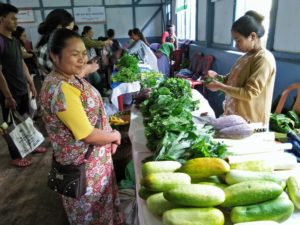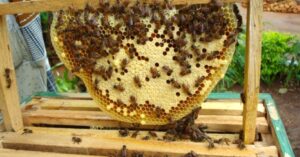Written by Nicholas Jason Iangrai
Imagine stepping into a forest where ancient practices still dictate the rhythm of nature. In Ladmawphlang village, Meghalaya, the forest is not merely a collection of trees but a living system nurtured by generations of knowledge and tradition. Here, regenerative forestry is not a new concept but a way of life, ensuring that forests do not just survive but continue to flourish. By carefully managing tree growth, the community ensures forests not only survive but thrive in harmony with nature.
Regenerative forestry follows a rotational approach, where specific plots are managed while others are left undisturbed for one or two years. In unmanaged conditions, large trees develop expansive, dense canopies that substantially reduce light penetration to the understory, suppressing the growth of smaller plants and wild edibles, thereby necessitating active human management. A key technique in this system is coppicing, where mature trees are cut close to the ground, leaving a stump from which new shoots can regenerate. This method not only creates space for younger trees to thrive but also promotes continuous regrowth from the same root system, ensuring a sustainable cycle of renewal.
One or two large trees are always left in each plot, acting as ‘parent’ trees that nurture the younger ones—almost like breastfeeding. This ensures that regeneration happens naturally while maintaining ecological balance. The harvested trees are then numbered and distributed among the community for use as firewood, planks, or charcoal, following strict village regulations. Importantly, leaves, small branches, and twigs are not burned but left to decay into compost, enriching the soil with essential nutrients. This natural layer retains moisture, reduces erosion by slowing water runoff, and supports beneficial microorganisms, fostering a healthier forest ecosystem.
Beyond rotational forestry, additional conservation measures, such as protecting restricted forests known as law adong, further safeguard biodiversity. Trees in these forests remain protected, with village authorities ensuring compliance to preserve these sacred spaces. The Village Council (Dorbar Shnong) plays a key role in deciding which plots to regenerate and when, ensuring that the practice remains sustainable. As a traditional governing body, it has long been responsible for conserving forests and preventing the overexploitation of natural resources. Through its guidance, the community follows a structured approach to forest management, balancing the needs of both people and the environment.
This traditional way of conserving forests brings immense ecological benefits. By allowing smaller plants such as flowers, vines, and mushrooms to flourish, it fosters biodiversity while also protecting the topsoil from erosion. At the same time, the regenerated forest provides shelter and sustenance for smaller animals like rabbits and squirrels, creating a balanced ecosystem where both flora and fauna thrive. To sustain this cycle, villagers follow a practice of compensatory planting, ensuring that for every tree cut, another is planted elsewhere.
For those who live amidst these forests, their value extends beyond ecology—it is a source of identity, sustenance, and intergenerational wisdom. As Bah Robin Nongrum, a community member from Ladmawphlang, aptly puts it, “Forests are the source of life, providing us with clean air, nourishment from trees and shrubs, and shelter for both humans and animals. One of the best ways to teach children about the richness of our forests is by taking them there, allowing them to see, touch, and learn the names of trees and shrubs firsthand. This not only deepens their understanding but also fosters a lifelong connection with nature.”
The community-led forest management, guided by traditional knowledge and village councils, has long ensured ecological balance in Ladmawphlang village. This philosophy of stewardship, embedded in village governance, highlights a crucial lesson: sustainable conservation is strongest when rooted in local wisdom. In a world grappling with deforestation, climate change, and biodiversity loss, the regenerative forestry practices of Ladmawphlang offer a powerful lesson in sustainability. These age-old methods demonstrate that conservation is not merely about preserving forests but about maintaining a dynamic and reciprocal relationship with nature. By following practices that balance human needs with ecological health, local communities of the village ensure that forests continue to thrive for generations to come.
As environmental challenges intensify, these age-old practices offer not just historical wisdom but a blueprint for the future of conservation. The involvement of community-led governance, such as the village council or Dorbar Shnong, further reinforces that environmental stewardship is most effective when rooted in local wisdom and collective responsibility. Preserving such traditional knowledge is more critical now than ever. Recognising, supporting, and integrating these indigenous practices into modern conservation efforts is no longer an option—it is a necessity.





